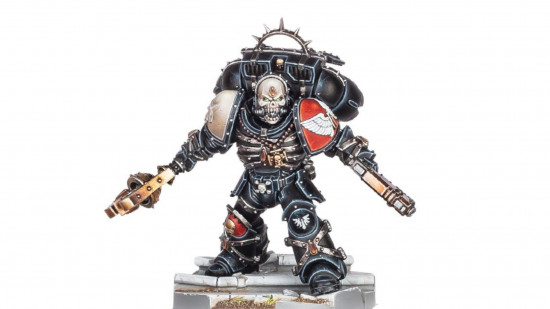The negative response to recently revealed Warhammer 40,000 Blood Angels miniatures, particularly the Sanguinary Guard, is frustratingly shallow. Taste is subjective, but there are still objective ways to discuss models: if the community used them, it might make the online discourse around new reveals that much less repetitive and tedious.
Warhammer 40k is a consumer entertainment product, but models are also sculptures. Phenomenally successful sculptures at that, with tens of thousands of Space Marines alone produced every year – the Museum of Modern Art has nothing on that. And as such we can assess Warhammer minis in some of the ways we might talk about fine art.
First, models are 3D objects, something that everyone seems to forget each time a photograph of a new miniature drops. While much of the design is apparent in a photograph, you can’t authoritatively judge a model until you see it in the plastic.
I’ve seen complaints that the new Chaplain Lemartes model has weird stumpy legs based only on the photo. My brother in the Emperor, he’s leaning forwards – his legs appear foreshortened due to perspective.
One angle that is rarely shown off in marketing images is the all important gods-eye view, how the model looks on the tabletop when you’re playing a game. It’s not a sexy angle, but it might be the most important – it’s how it will look for most of the time that you’re actually using it. Like looking at a photograph of the Statue of Liberty and saying “That’s tiny!”, a picture doesn’t capture how we will relate to a model when we actually have it in hand.
The upcoming Blood Angels models all represent post-humans, so it’s worth considering how well they represent human anatomy. And like all Primaris Space Marines – capture human anatomical proportions better than any of the firstborn Space Marine kits that came before them.
Whether that is good or bad is a matter of taste: the old-school sculpting style, with exaggerated hands and heads, and slightly abstracted Space Marine armor which couldn’t realistically articulate at the waist or hips, is cartoony, and that’s fine – it’s dynamic, iconic.
More realistic anatomy factors into the kind of poses and forms the models can assume – stubby limbs and immobile torsos can’t replicate the full range of human posture. Space Marines are not one of the most balletic Warhammer 40k factions, but their forms can still capture implied motion, and have well defined lines of interest for the eye to follow.
The new Sanguinary Guard are monopose, compared to the originals, which had posable limbs. This allows the sculptor to create gestures that are unified across the whole body: their torsos can be sculpted as bent, twisted, or extended, so they continue the movement of their arms and legs.
Better proportions and fixed poses give the new models more strongly defined, and more naturalistic, forms. There are clear lines of interest for the eye to follow through the new models, from upraised blade point to leading toe; a better defined center of gravity; and more implied motion, such as a torso unwinding to deliver a sword cut, than were present in the old models.
Changes in technology and casting material also contribute to more dynamic, sculptural forms. The new Astorath the Grim model is a one for one remake of the original model, but it takes advantage of light and rigid plastic to balance on a single foot, rather than the pile of scrolls that supported the previous sculpt. The result is a model with a more strongly defined silhouette, a downward spear-point compared to the original’s cylinder, and more obvious forward momentum.
The new Blood Angels are often less busy with surface details than the older models. As noted above, Astorath is as hyper-detailed as ever, and while Lemartes’ details are different they’re no less omnipresent, so we can infer that the lower detail level is intentional. It’s worth asking what has been achieved by reducing their bling.
The Sanguinary Guard have fewer and subtler ornaments, but retain the molded musculature on their armor. With less baroque detail, they look more like classical sculptures, and less like neoclassical ornamentation imitating classical sculpture. It’s a different kind of gothic reference, but not a lesser one.
Many details are preserved, like the wings and head crests, only smaller than before. In part, this level of fine detail was simply impossible on the previous, hand-sculpted models – and in part, now that the models themselves have more realistic proportions, cartoony accessories would also look wrong.
With all that said, you’re well within your rights to compare these models with the new Stormcast Eternals Prosecutors and Knight Azyros and decide that you prefer the busy and baroque gothic detailing; or to the old sculpts, and decide you prefer the solid, exaggerated proportions of the classic Warhammer sculpting style.
But please, let the next community discussion about a miniature reveal have more nuance than a thousand “Look how they massacred my boy” memes.
After all my snark and complaining, here’s an article about how lovely the Warhammer community can be, just as a refresher.
Source: Wargamer




